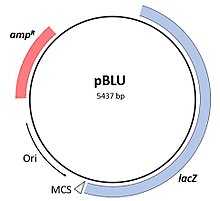
Back عناصر وراثية متحركة Arabic Mobil genetik elementlər Azerbaijani Мабільныя генетычныя элементы Byelorussian Element mòbil genètic Catalan Mobiles genetisches Element German Elementos genéticos móviles Spanish عناصر متحرک ژنتیکی Persian Élément génétique mobile French Elemento xenético móbil Galician אלמנטים גנטיים ניידים HE

Mobile genetic elements (MGEs), sometimes called selfish genetic elements,[1] are a type of genetic material that can move around within a genome, or that can be transferred from one species or replicon to another. MGEs are found in all organisms. In humans, approximately 50% of the genome are thought to be MGEs.[2] MGEs play a distinct role in evolution. Gene duplication events can also happen through the mechanism of MGEs. MGEs can also cause mutations in protein coding regions, which alters the protein functions. These mechanisms can also rearrange genes in the host genome generating variation. These mechanism can increase fitness by gaining new or additional functions. An example of MGEs in evolutionary context are that virulence factors and antibiotic resistance genes of MGEs can be transported to share genetic code with neighboring bacteria. However, MGEs can also decrease fitness by introducing disease-causing alleles or mutations.[3] The set of MGEs in an organism is called a mobilome, which is composed of a large number of plasmids, transposons and viruses.[4]

- ^ Cite error: The named reference
Moreira_2009was invoked but never defined (see the help page). - ^ Mu X, Ahmad S, Hur S (2016). Endogenous Retroelements and the Host Innate Immune Sensors. Advances in Immunology. Vol. 132. pp. 47–69. doi:10.1016/bs.ai.2016.07.001. ISBN 9780128047972. PMC 5135014. PMID 27769507.
- ^ Singh PK, Bourque G, Craig NL, Dubnau JT, Feschotte C, Flasch DA, et al. (2014-11-18). "Mobile genetic elements and genome evolution 2014". Mobile DNA. 5: 26. doi:10.1186/1759-8753-5-26. PMC 4363357. PMID 30117500.
- ^ Cite error: The named reference
wolfwas invoked but never defined (see the help page).